Key Insights
- Filecoin’s storage market continued to grow in Q3’23, as active deals were up 45% QoQ and nearly 10x YoY. Simultaneously, as Filecoin’s storage capacity decreased 10% QoQ, storage utilization grew from nearly 8% in Q2’23 to almost 13% in Q3’23.
- As per the end of Q3’23, nearly 1,900 clients have onboarded datasets on Filecoin. Of those clients, 422 clients onboarded large datasets (over 1,000 TiB in storage size), up 25% QoQ.
- Protocol revenue from storage fees decreased 68% in FIL terms in Q3’23 (down 73% in USD terms), in line with the overall decline in demand-side revenue across the decentralized cloud storage space.
- The Filecoin Virtual Machine (FVM) brought Ethereum-style smart contracts to enable new use cases, including liquid staking, perpetual storage, and decentralized retrieval, and compute. Both net deposits and borrows saw sustained growth in Q3’23.
- The deployment of Uniswap contracts on the FVM will likely usher in a new phase of DeFi applications built on the Filecoin network.
Primer on Filecoin
Relying on centralized data storage has a major shortcoming: it’s hard to systematically verify the integrity of the stored data. The Filecoin storage network is a peer-to-peer version of Amazon S3. It’s built on top of the InterPlanetary File System (IPFS), which serves as the Filecoin network’s distributed data storage and sharing layer. Filecoin regularly verifies the storage of data and uses deals that price the storage based on supply and demand dynamics, instead of a fixed pricing structure.
A storage deal is like a contract with a service-level agreement (SLA) — users pay fees to storage providers to store data for a specified duration. To keep data safe, Filecoin uses a cryptoeconomic incentive model that regularly verifies the storage with zero-knowledge proofs.To incentivize storage providers to participate in deals, Filecoin rewards them with FIL, the network’s native token. Storage providers are also slashed in the event they either fail to provide reliable uptime or act maliciously against the network.
To retrieve data, Filecoin users pay a retrieval provider to fetch the data. Unlike storage deals, which involve transactions onchain, retrieval deals use payment channels to settle payments offchain, resulting in faster retrieval.
The launch of the Filecoin Virtual Machine (FVM) in March 2023 brought Ethereum-style smart contracts to enable new use cases on Filecoin, including liquid staking, perpetual storage, and decentralized compute.
Key Metrics
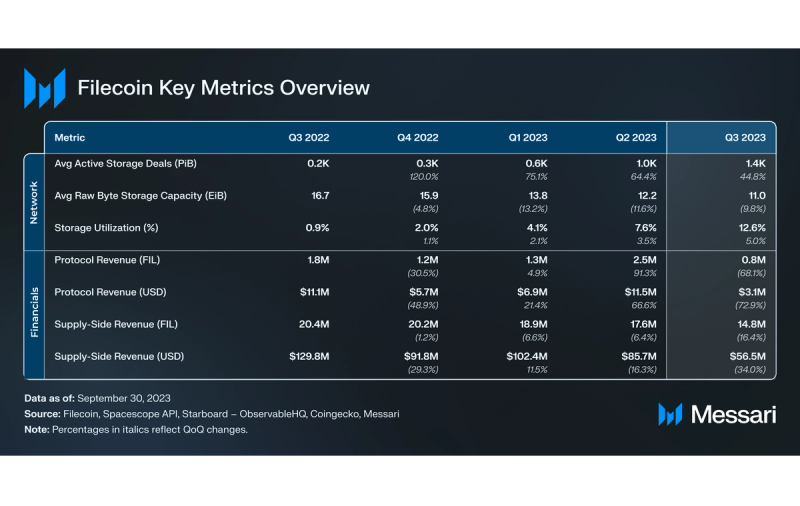
Performance Analysis
The Filecoin blockchain is used to store data decentrally by both:
- The demand side, i.e., storage users in need of data storage, and
- The supply side, i.e., storage providers with excess capacity of the network.
Usage
The amount of data stored in active deals between storage users and storage providers gauges the demand for Filecoin storage from both Web2 and Web3 clients.
Storage Deals
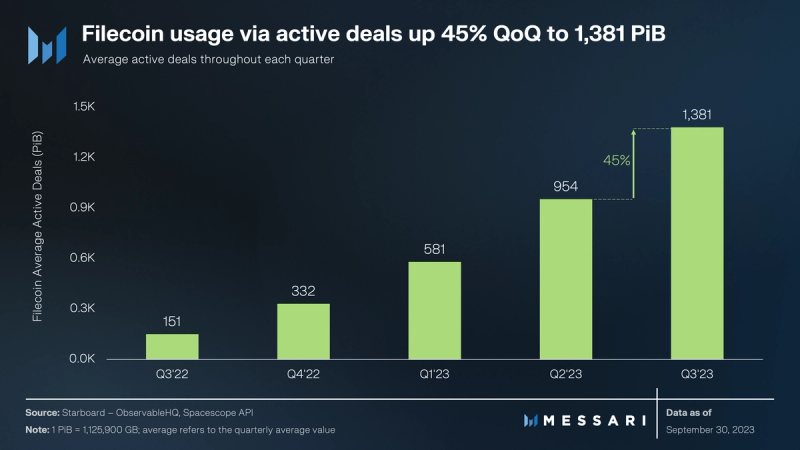
In Q3’23, Filecoin continued its adoption of decentralized storage by means of active deal growth. Nearly 1,400 PiBs were stored on the Filecoin network through active deals in Q3’23, up 45% QoQ from 945 PiB in Q2’23 and up nearly 10x YoY from 151 PiB in Q3’22.
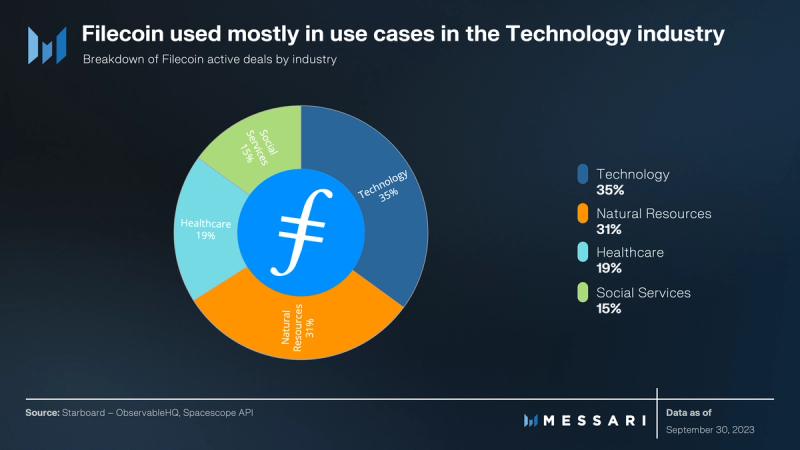
A breakdown of the active storage deals by their use cases reveals the industries that leverage Filecoin Plus most are Technology (35%) and Natural Resources (31%). To encourage usage via active deals, Filecoin offers a suite of services, including Singularity.Storage, NFT.Storage and Web3.Storage.

Simultaneously, daily new deals grew 6% QoQ, which is a slowdown relative to the accelerated growth of 47% QoQ in Q2’23. On the one hand, this slowdown in new deal growth corresponds to an overall reduction in rewards to storage providers (as discussed later in the Supply-Side Revenue section). On the other hand, new deals being added corresponded to an increase in the utilization of the Filecoin network.
Storage Utilization vs. Capacity
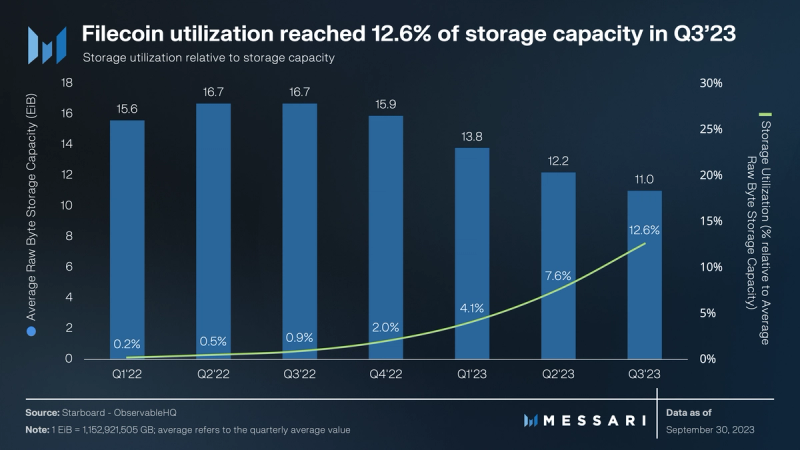
Filecoin’s storage utilization relative to the total available storage capacity increased to 12.6% in Q3’23, up from 7.6% in Q2’23. While this increase is a positive sign in terms of Filecoin’s adoption through active storage deals, it has to be put in the context of its network’s capacity.
In Q3’23, Filecoin experienced a 12% QoQ decline in average raw byte storage capacity, dropping to approximately 11 EiB. Since about a year ago, this metric had declined gradually after average raw byte storage capacity reached its all-time high at nearly 17 EiB in Q3’22.
The decline in storage capacity is further reflected by the drop in the total number of storage providers. After reaching an all-time high of over 4,100 in Q3’22, the metric continuously declined to over 3,400 by the end of Q3’23. To accommodate for the decrease in average storage capacity and simplify the onboarding of storage providers onto the platform, Filecoin has partnered with servers.com to deliver data centers on demand. The partnership seeks to reduce time to market for new storage providers by up to 75%, from 6-12 months to 6-8 weeks.
Storage Clients
As per Messari’s guide on decentralized storage networks, Filecoin is currently suitable for providing cold storage solutions (e.g., archival and recovery) for enterprises and developers. Its competitive pricing and ease of access make it an appealing choice for Web2 clients seeking cost-effective alternatives for storing large amounts of archival data.
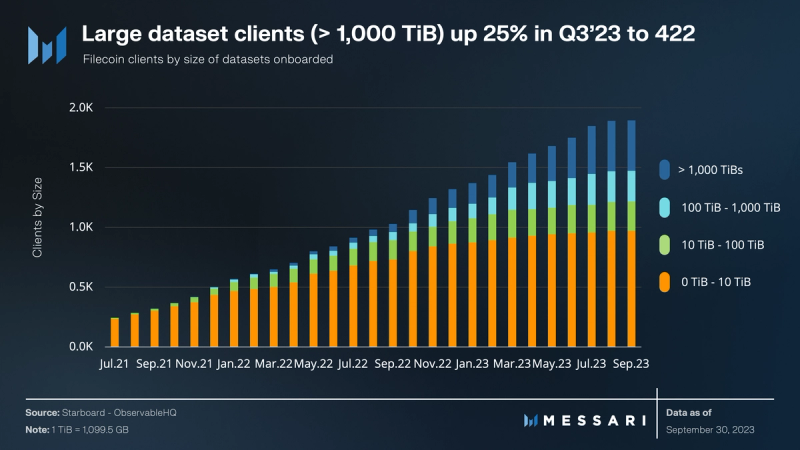
As per the end of Q3’23, a total of 1,891 clients have onboarded datasets on Filecoin. Of those clients, 422 onboarded large datasets (e.g., datasets that exceed 1,000 TiB in storage size), up 25% from 338 in Q2’23. Simultaneously, the percentage of clients with total upload volume higher than 100 TiB increased 17% QoQ, from 570 in June to 666 in September.
According to Filecoin’s client explorer, major clients range from New York City and the USC Shoah Foundation to Web3 platforms such as OpenSea or the Layer-1 network Solana. Further notable efforts that leverage the Filecoin network include:
- The Victor Chang Cardiac Research Institute to safeguard and share research data
- Democracy’s Library storing datasets collected by the Internet Archive at the end of administration
- SETI Institute using Filecoin to store astronomical research data
- UC Berkeley collaborating with Seal Storage for storing physics research
- GenRAIT leveraging Estuary to store critical genomics data on Filecoin
- The research center Starling Lab storing sensitive digital records of human history
- Ewesion (China’s fastest growing host of graphic files) using Filecoin for data preservation.
An overview of featured clients leveraging the Filecoin network can be accessed here.
Retrievals
To serve storage retrieval needs, a content delivery network (CDN) for Filecoin and IPFS – called Project Saturn – is currently being developed. Saturn aims to serve Filecoin’s retrieval market through fast and low-cost content delivery. Its node operators are incentivized to fulfill retrieval requests by earning FIL from a monthly pool of approximately 30,000 FIL.
In terms of retrieval performance, the goal of Saturn is to provide reliable content retrieval for both Web2 and Web3 use cases. It’s focused on improving the speed and performance of retrievals, with the majority of data being mirrored from IPFS. A deep dive into Saturn’s decentralized CDN, its traction to date, and its roadmap is available here.
As per the end of Q3’23, there were more than 1,800 nodes globally, geographically distributed as follows:
- Europe: 766 nodes (42%)
- North America: 531 nodes (29%)
- Asia: 409 nodes (22%), and
- The rest: 120 nodes (7%) distributed across South America, Africa, and Oceania.
An overview of Saturn’s node performance is available in the Saturn dashboard.
FVM Usage
Introduced at the end of Q1’23, the Filecoin Virtual Machine (FVM) brought Ethereum-style smart contracts to Filecoin. Leasing and staking apps allow storage providers greater access to FIL, thus potentially making data onboarding more efficient. As of September 30, 2023, more than 2,000 unique contracts have been deployed on FVM and used by over 560,000 unique users collectively generating over 1.6 million transactions.
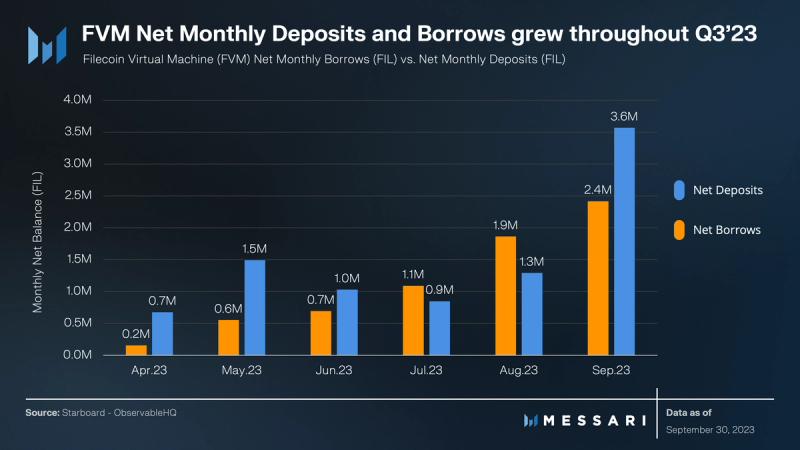
According to the FVM Explorer, as of September 30, total DeFi net deposits from over 2,900 stakers accounted for almost 9 million FIL (approx. $30 million) since the launch of the FVM. Simultaneously, net borrows reached 6.8 million FIL (almost $23 million). During Q3’23, both net deposits and borrows saw sustained growth. On a monthly basis, both net monthly deposits and borrows reached all-time highs in September at 3.6 million FIL (over $12 million) and 2.4 million FIL (over $8 million), respectively.
The FVM DeFi leaderboard shows the following distribution of the net deposits:
- 5.9 million FIL (approx. 57%) in GLIF,
- 2.4 million FIL(approx. 23%) in STFIL,
- 1.9 million FIL(approx. 13%) in HashKing.
A successful proposal to deploy Uniswap contracts on the FVM came after the increase in FIL staked since the launch of FVM. The deployment of Uniswap contracts on the mainnet is expected to usher in a new phase of DeFi applications built on the Filecoin network. As Filecoin continues to acquire new users and onboard valuable datasets, it may serve as a base for developing monetizable FVM-enabled use cases around data.
Revenue
Filecoin’s revenue framework is similar to Ethereum’s because its transaction fee design is similar to the EIP-1559 mechanism. This gas system consists of network fees that are burned to compensate for the resources used. Both storage users and storage providers generate protocol revenue.
Protocol Revenue
As per Messari’s revenue analysis, Filecoin’s protocol revenue represents the sum of:
- Base fees – Determined by message congestion and required by any storage proof.
- Batch fees – Used for bundling storage proofs.
- Overestimation fees – Required to optimize gas usage.
- Penalty fees – Collected for storage provider failures.
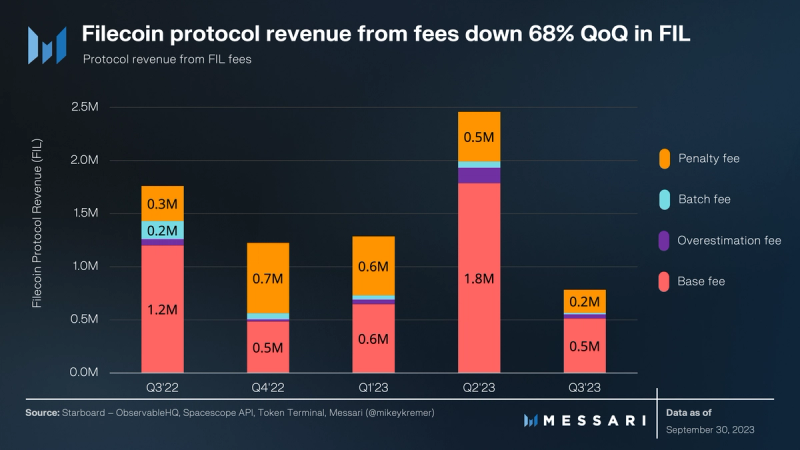
While demand for FIlecoin storage went up, protocol revenue from FIL fees decreased 69% in Q3’23 to 0.8 million FIL (down 73% in USD terms to $3.1 million). This decline in protocol revenue is in line with the overall decline in demand-side revenue across the decentralized cloud storage space.
The main contributor to the decline in Filecoin’s protocol revenue are demand-side base fees, down 72% QoQ in FIL terms. Filecoin is actively working on reducing costs for onboarding data on its network, e.g., through the Decentralized Storage Alliance (DSA) initiative to reduce decentralized storage costs by 40%. In line with base fee declining, all the other FIL fees that accrue to the protocol revenue (penalty, batch, and overestimation fees) declined QoQ. The only portion of FIL fees that isn’t burned by the protocol is the “tip” collected by block miners. This mechanism is used to express transaction priority on the supply-side of the network. Therefore, this “tip” counts as supply-side revenue.
Supply-Side Revenue
Filecoin’s supply-side revenue consists of:
- Block rewards disbursed by the network to storage providers.
- Storage deal payments that are anchored via contracts.
- “Tips” to speed-up transactions.
Block rewards account for more than 99.9% of supply-side revenue in Q2’23, while “tips” accounted for only a small portion. The minting mechanism of new FIL tokens relies on both:
- An exponential decay model (30% of tokens): Block rewards are highest initially to stimulate participation and then decrease exponentially over time.
- A baseline model (70% of tokens): Block rewards are indexed according to the growth of the network’s storage capacity.
Combining these two models helps Filecoin maintain participation after block reward distribution in the early stages of the network (see exponential decay model). It also helps continuously reward additional value created for the network through increased storage capacity (see baseline model).
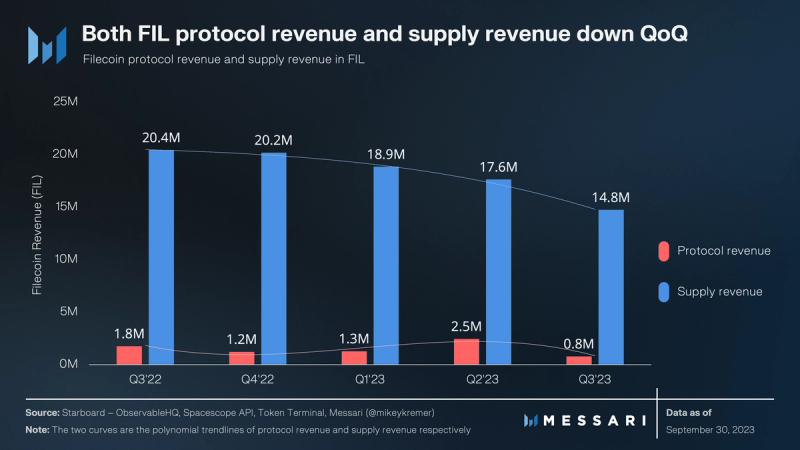
Supply-side revenue in FIL decreased 16% in Q2’23 to 14.8 million FIL (down 34% in USD terms). The decrease was driven by an overall reduction of FIL reward issuance due to the exponential decay model and primarily the baseline minting model. The decrease in FIL reward issuance will likely continue in the coming quarters. For an in-depth discussion and various simulations of future FIL issuance, please refer to Messari’s recent investigation on the FIL circulating supply.
Ecosystem Overview
The Filecoin ecosystem has been actively developing a funnel of builders. It has regularly engaged in hackathons and accelerators to help early-stage projects and teams receive funding from Protocol Labs or affiliated entities. The ecosystem is channeled toward onboarding various use cases: namely, from data infrastructure, media streaming, metaverse, and gaming.
Use Cases
As of September 2023, 115 known projects were developed within the Filecoin Ecosystem. Most projects that leverage Filecoin offer data services:
- Banyan: Web2-like storage functionalities.
- Ocean Protocol: Developer tools and platform for data marketplaces.
- Numbers Protocol: Preserve data authenticity.
- Berty: Secure messaging and social media application.
- Dether: Cash on- / off-ramp and diverse financial transactions.
- Tableland: Decentralized cloud database.
Media and entertainment-focused protocols include:
- Mona: 3D art gallery in the metaverse.
- NFTwitch: NFT minting platform for Twitch content.
- Huddle01: Decentralized video conferencing.
- OP Games: NFT minting from games.
- FileMarket: Web3 shop builder and marketplace.
- Xone: Metaverse solution that connects artists and fans.
Several use cases aim to leverage Filecoin’s infrastructure to power highly specific data needs:
- Koios: No-code data DAO platform.
- Cryptosat: Uses mini-satellites to prevent side-channel attacks and allow for secure verifiability.
- Bela Supernova: Store patients’ health data.
- Slate: Search engine for handling and sharing personal data.
- ZKsig NFTs: Access control to marketplace.
- DataMarket: Data purchase and checkout functionalities.
Start-ups actively building on FVM include:
- STFIL: Filecoin liquid staking & leveraged farming protocol.
- Lighthouse: Perpetual data storage service with a one-time payment pricing model.
- GLIF: Builder of apps and tools for the Filecoin Network.
- MineFi: Income platform for storage providers.
- ZKAmoeba: Layer-2 protocol that scales Filecoin using zk-tech
An overview of the projects building in the Filecoin ecosystem can be found here.
Accelerators & Hackathons
Longhash Ventures’ Web3 accelerators arm, LongHashX, partnered with Protocol Labs, the “FVM Genesis Cohort” to support developers of decentralized apps focused on FVM.
The Decentralized Storage Provider Accelerator (DSPA) is a 6-month program in Asia. It offers training and support for storage providers looking to expand into decentralized data services on the Filecoin network.
The Enterprise Storage Provider Accelerator (ESPA) offers a 7-month training opportunity for individuals looking to enter the decentralized storage provider space, featuring both technical and business sessions.
The HackFS is an async hackathon with $150,000 in prizes to startups building Web3 infrastructure and applications in the Ethereum ecosystem.
The Open Data Hack is a 3-week online hackathon featuring technical workshops and bounties for projects building in the Filecoin community.
Qualitative Analysis
Releases
V21 Network Upgrade
Filecoin core developers proposed a timeline and scope for the upcoming V21 network upgrade, Watermelon. The mainnet upgrade is tentatively scheduled for Nov. 7, 2023. The following Filecoin Improvement Proposals (FIPs) are in scope for the upgrade:
- FIP0052: Increase max sector commitment to 3.5 years
- FIP0057 Update: Add batch balancer parameter recalibration
- FIP0059: Synthetic Proof-of-Replication (PoRep)
- FIP0063: Switching to new drand mainnet network
- FIP0065: Ignore built-in market locked balance in circulating supply calculation
- FIP0070: Allowing storage providers to move partitions between deadlines
Venus V1.13 Series
Venus V1.13.0 was released on Aug. 30, 2023. This release updates the minimum Go version required to 1.19, updates the issue template enhancement.yml, and features query parameters for messages and deals. A complete list of changes can be found in the release notes.
Filscan UI and Metric Adjustments
Filscan is set to launch several updates and enhancements, including:
- A full UI upgrade to provide users with an improved product experience.
- Adjusted data metrics, including new additions for Storage Provider (SP) and Filecoin Virtual Machine (FEVM) data.
Key Events
Partnership with Brave and ECC
Brave, Electric Coin Co. (ECC), and Filecoin Foundation have teamed up to enhance privacy features in the Brave browser. They plan to integrate the Zcash protocol into the Brave’s crypto wallet, enabling users to securely manage ZEC and other cryptocurrencies. Additionally, they are working on a privacy-focused feature for private messaging and media transmission using the Zcash protocol, with the InterPlanetary File System (IPFS) providing secure storage for encrypted content.
Consensys Scale Program
Protocol Labs and Consensys partnered to launch the Consensys Scale Program, which is designed to assist blockchain ventures in the Seed to Series A stages. This program is intended for more advanced-stage projects with a well-established team, institutional funding, and some level of product-market fit.
Filecoin Mining and Staking Service
Bitmain, a crypto mining machine manufacturer, is entering the Filecoin mining sector with a new model priced at nearly $40,000 per unit. Users have the option to host these machines on Bitmain’s Antpool mining pool platform for Filecoin rewards. Additionally, Bitmain is introducing a delegated staking service for Filecoin with a 0.5% monthly fee, enabling users to delegate their tokens to a third party like Antpool. For context, storage providers on Filecoin earn mining rewards based on their storage capacity, while tokenholders can stake FIL tokens for consensus and governance rewards.
Closing Summary
Storage use on Filecoin experienced accelerated growth in Q3’23 with active storage deals, increasing by 45% QoQ and nearly 10x YoY. Clients onboarding large datasets on the Filecoin network also grew 25% QoQ. While storage capacity decreased 10% QoQ, storage utilization grew from 7.6% in Q2’23 to 12.6% in Q3’23. Revenue from storage fees decreased 68% in FIL terms in Q3’23 (down 73% in USD terms), in line with the overall decline in demand-side revenue across the decentralized cloud storage space.
The Filecoin Virtual Machine (FVM) brought Ethereum-style smart contracts to enable new use cases, including liquid staking, perpetual storage, and decentralized compute. Both net deposits and borrows saw sustained growth in Q3. An onchain vote to deploy Uniswap contracts on the FVM will likely usher in a new phase of DeFi applications built on the Filecoin network.
As Filecoin continues to acquire new users and onboard valuable datasets, it may serve as a base for developing monetizable FVM-enabled use cases around data. Prominent examples include perpetual storage (similar to Arweave), undercollateralized loans to storage providers, and decentralized computing. Should Filecoin continue to onboard demand, it stands a chance at becoming a prominent provider of decentralized storage and cloud services for Web3 and traditional applications.




















